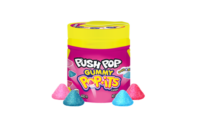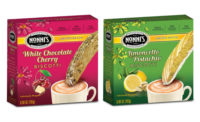In a way, sliding fruits and nuts between two slabs of chocolate is just like spreading peanut butter and jelly between two slices of bread.
The classic sweet-and-salty, fruity-and-nutty combination gives chocolate (and sandwich) lovers a complete tasting experience plus all the protein and vitamins they need.
And, in today’s increasingly health-conscious society, “complete confections” allow consumers worldwide to indulge — and still feel good about it.
Luckily, the continued use of fruits and nuts in sweets — and the health benefits and variety they provide — give consumers a way to enjoy their treats and take something from them, too.
Wholesome and gratifying
For years, doctors have told their patients to eat fruits and vegetables for the fiber and nutrients they inherently provide. And while doctors may not have had confections in mind, Chris DiLorenzo, president and ceo of fruit supplier Pocantico Resources, Inc., says the addition of fruit can help the consumers who are going to eat the sweets anyway.
“More and more clinical work is being done to show that a good, balanced diet — one full of fruits and vegetables — is just beneficial, so the guilt side of indulging in a confection, if it has some fruit in it, is minimized,” he says.
How exactly can fruit make concerned consumers feel better about, say, downing an entire chocolate bar? Lorenzo says the antioxidants and vitamins found in many berries can give confections a nutritional boost.
“The three major ones and the three fruits that are most widely sold here are strawberry, blueberry and raspberry, but other fruits can be used for other health benefits,” DiLorenzo says. “Obviously, ‘super fruits’ such as acerola, acai, maqui (work well), but in my opinion, they’re all ‘super fruits.’ They are super in their own right.”
In addition to vitamins and oxidants, which the National Institutes of Health say could prevent cancer, heart disease and other ailments, fruit also contain fiber and prebiotics that promote healthy digestive systems.
Of course, nuts offer many of the same benefits, even if they aren’t as sweet as their confectionery counterparts.
Bill Morecraft, general manager for Blue Diamond Almond’s Global Ingredients Division, says a 28-gram serving of almonds packs a powerful — and nourishing — punch.
“Besides having great taste and great texture that go very well with confections, almonds have more calcium than milk, more protein than eggs, they are natural source of vitamin E and they are cholesterol-free and gluten-free,” he says. “They really sit into an increasing awareness worldwide of the need for healthier eating.”
The lack of cholesterol, per a 2003 study by the U.S. Department of Agriculture, could make almonds an important tool for supporting a healthy heart. Moreover, the Almond Board of California says almonds can be beneficial for weight maintenance, diabetes control and other health issues.
Not bad for an ingredient found in some of the world’s favorite confections.
It may also explain why more confectioners worldwide are continuing to incorporate them into their chocolates and sweets. The Almond Board’s May 2012 report says confectionery was the main avenue for new almond products in North America, Europe, Asia, the Middle East and Africa in the last year.
“One of the things that has really increased in recent years is the awareness that tree nuts and almonds in particular are a very healthy additive,” Morecraft says. “The trend toward natural ingredients, due to increasing awareness globally of health issues, has increased the usage of almonds.”
Not all nuts come from trees, however. The peanut, for example, comes from the ground and offers just as many healthful qualities.
“Peanuts are very healthy in their amino profile — they are very healthy for the heart,” says Bruce Kotz, Golden Peanut Co.’s vice president of specialty products. “Compared to other products, they are very low in saturated fats, so they are a good source of oil. They do provide a little bit of fiber.”
The peanut’s main perk, however, is its ability to keep consumers’ stomachs full, Kotz says, which by extension, can keep their waistlines trim.
“More importantly, peanuts and peanut products supply satiety, or that fullness effect,” he explains. “Indirectly, when you eat peanuts or items containing peanuts, you feel a lot fuller than you do when you eat straight carbohydrates.”
These benefits, in addition to taste, make peanuts a clear choice for confectioners.
“They are healthy for you, they are filling nuts and they are very nutritive with protein and good fat, so I don’t see any reason why we won’t continue to see growth in peanut-containing confections,” Kotz says.
Delicious diversification
In addition to offering plenty of health benefits, fruit and nuts can “spice up” sweets and snacks, so to speak.
DiLorenzo, whose Tarrytown, N.Y. company offers whole, sliced, freeze-dried, powdered and granulated fruits, says adding fruit to confections can change its texture — and interest factor.
“Fruit can add different textures depending on the type,” DiLorenzo says. “If it’s a low-moisture fruit, such as a freeze-dried fruit, it can add a crunch into a confection or chocolate-coated product. If it’s juice-infused or medium-moisture, such as 10 to 12% moisture, it can add a chew into a confection.”
And with their hard and crunchy texture, nuts can give chocolates and other treats an often-needed lift, both in consistency and sales, Morecraft says.
“Confectioners that sell chocolate products generally can sell a chocolate product with almonds as an ingredient for about 10% more than they can sell a chocolate product with no almonds,” he says.
Those sales won’t matter, though, if a confection’s flavor profile doesn’t peak the consumer’s interest.
One way to do that, DiLorenzo says, is by using new flavors that reflects shifts in the population and their palates.
“There is a growing area, in North America at least, for more of the Latin fruits based on our population and demographic change,” he says. “You can see the mango, the papaya, and the banana has historically always been here, but some of the fruits that are more known in countries south, i.e. Mexico, Latin America, Brazil, are becoming more mainstream here because of the demographic shift.”
But no matter which fruits or nuts are used — or how — they will always be an essential part of candy making.
Or in other words, they are the versatile, healthy peanut butter to confectionery’s thankful jelly.











